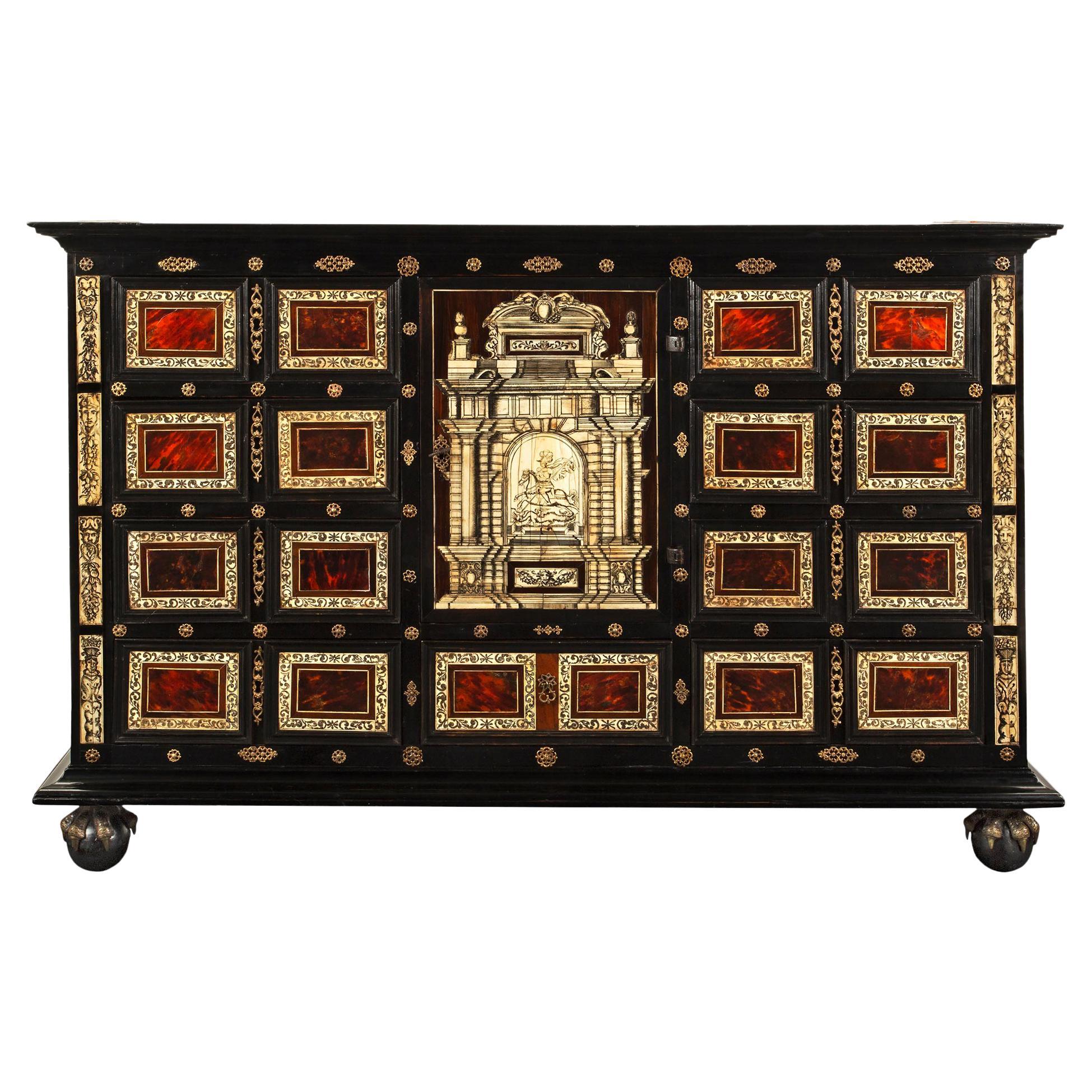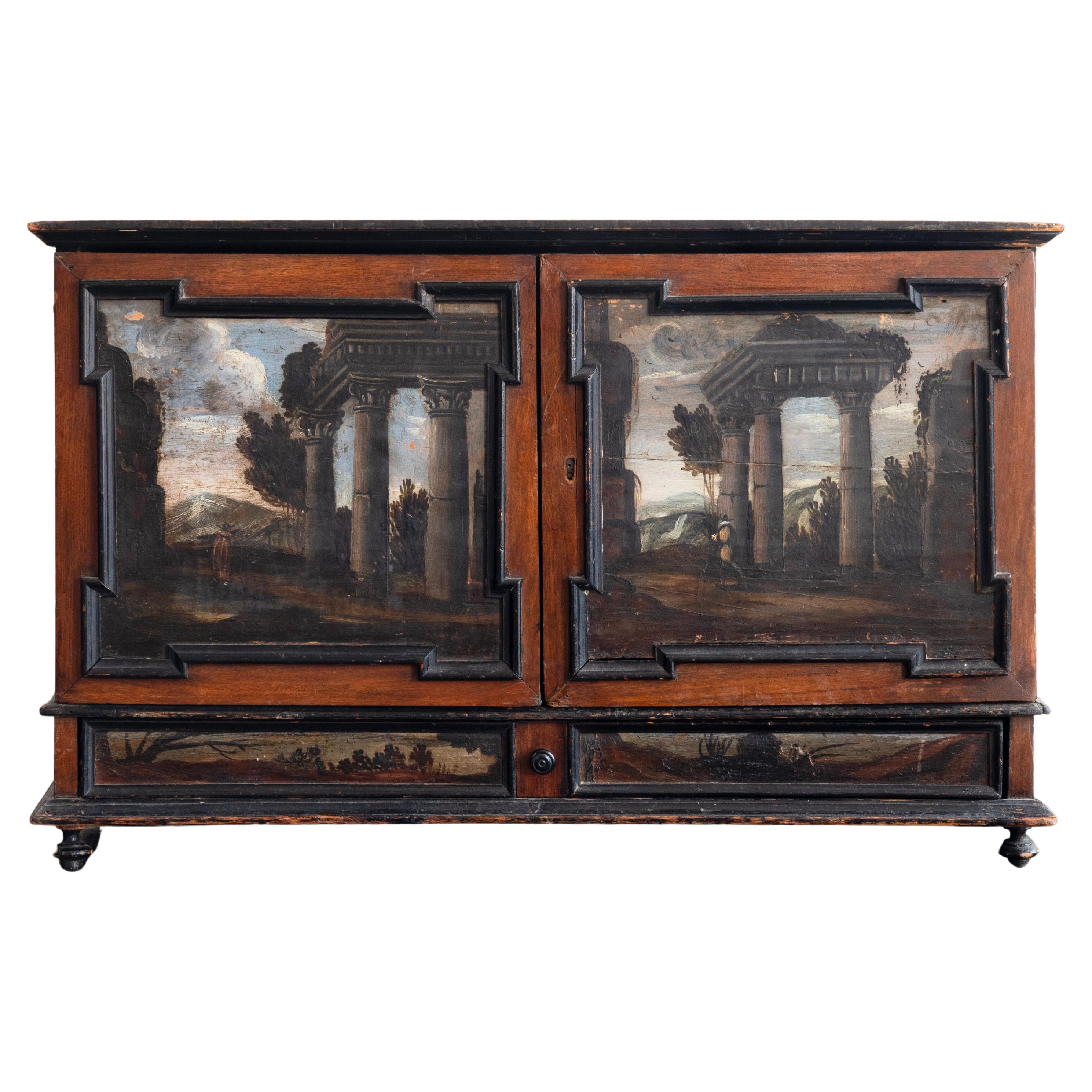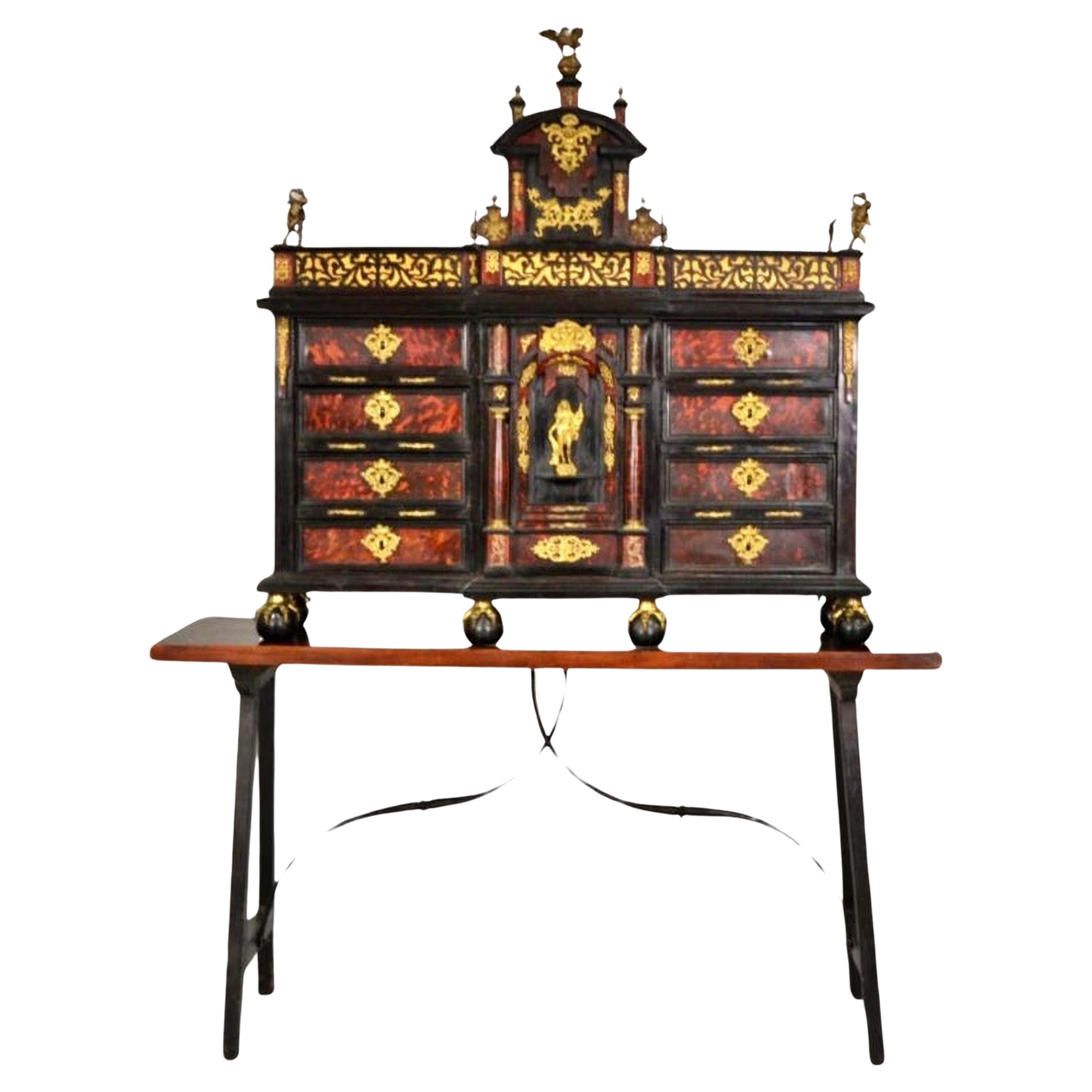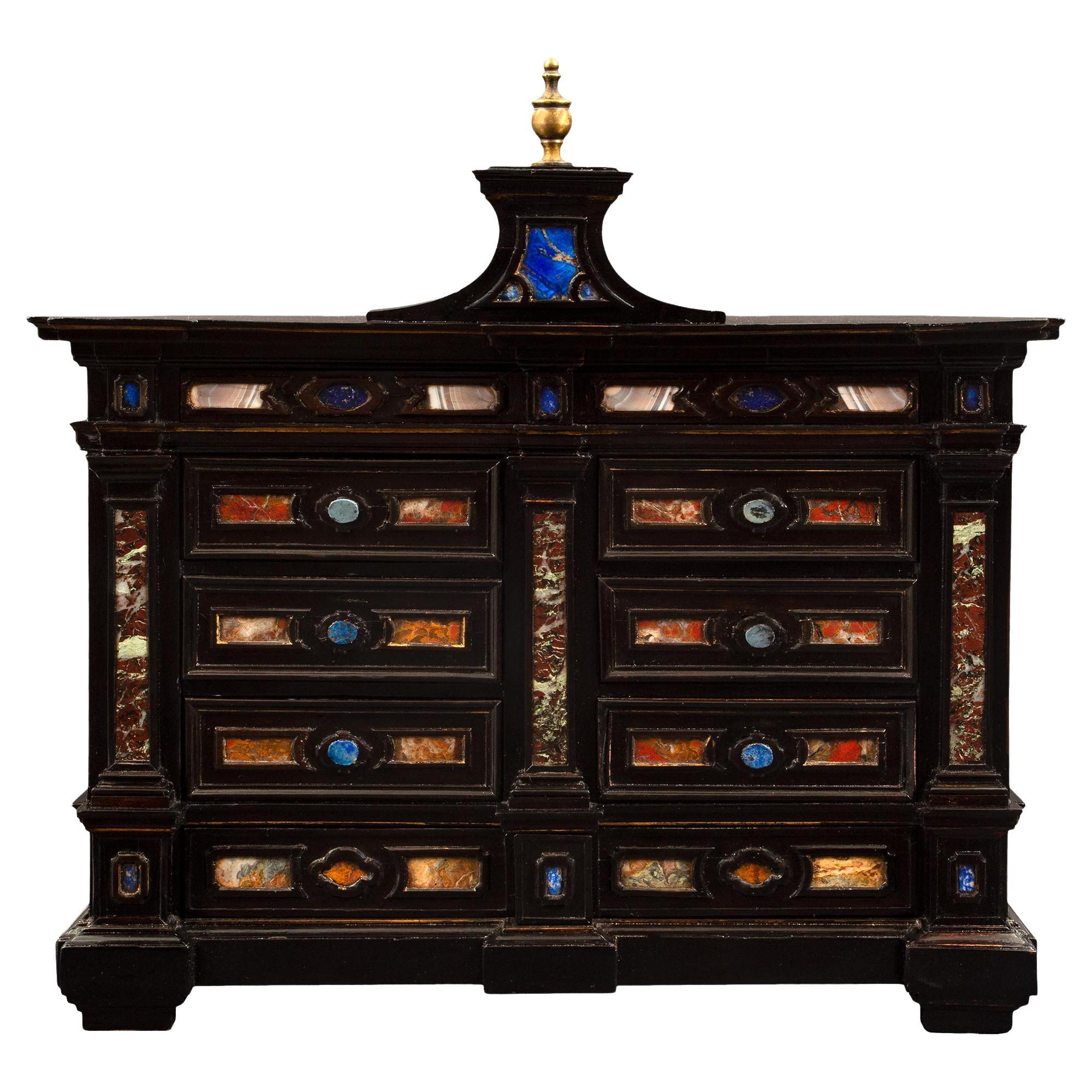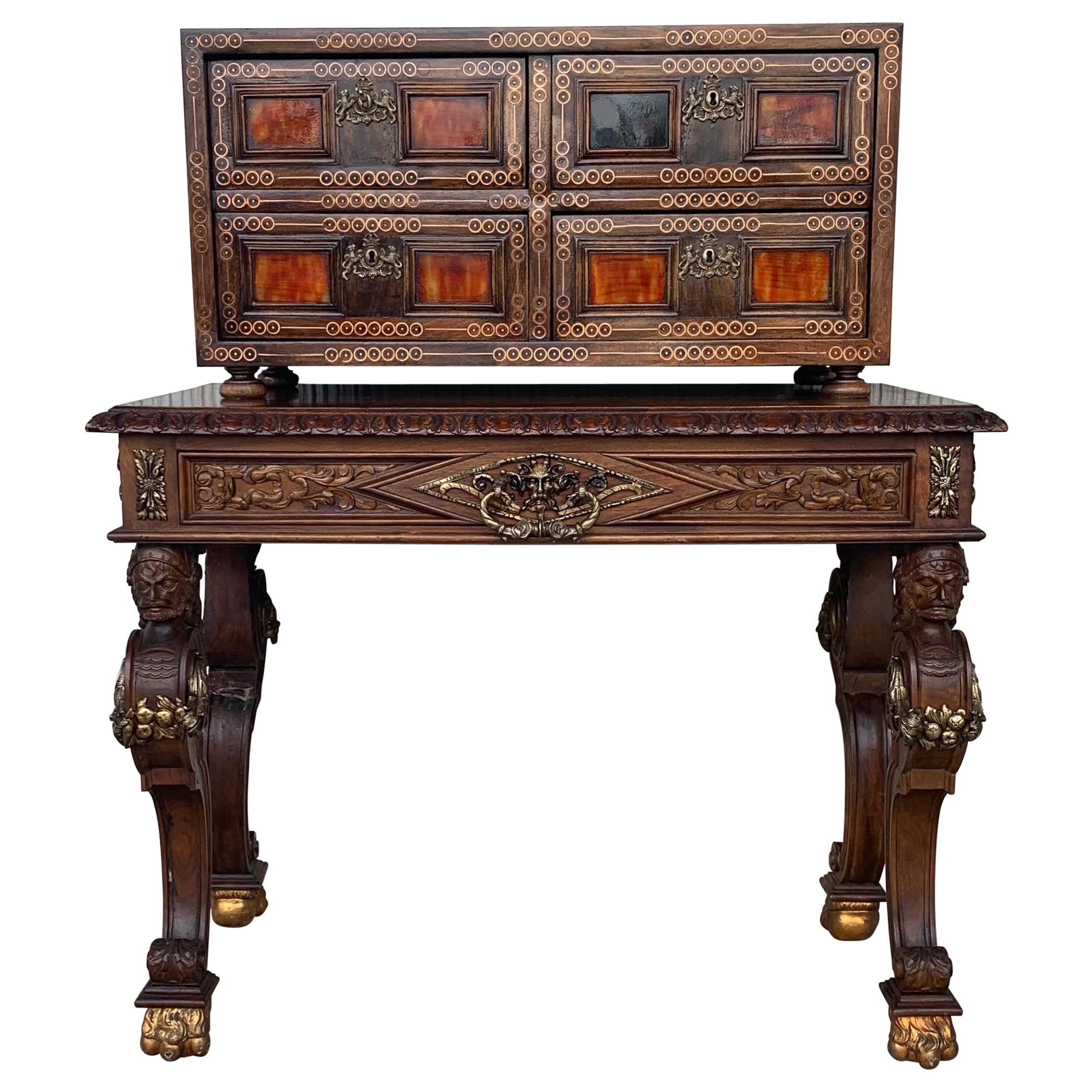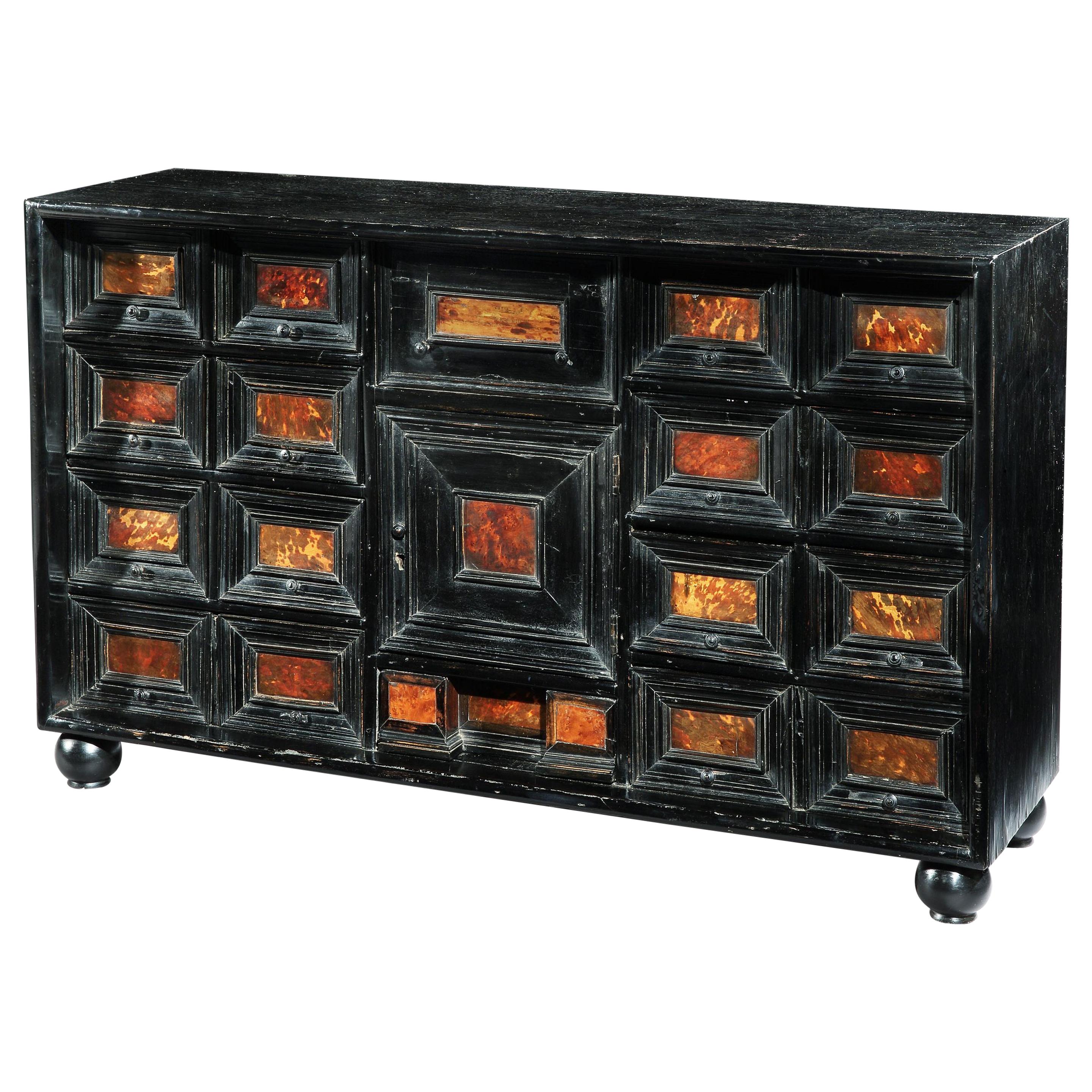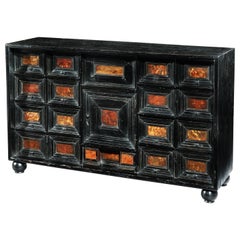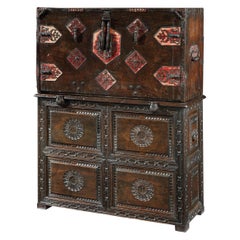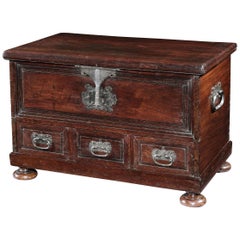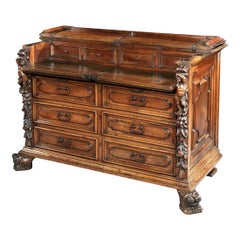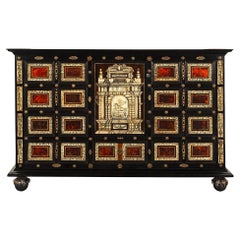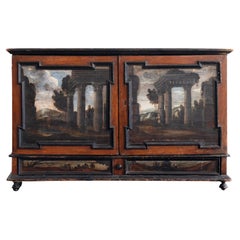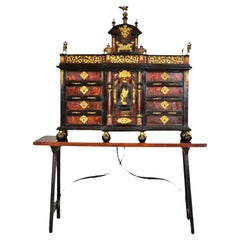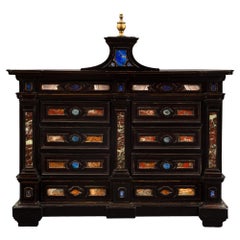Items Similar to Table Cabinet, Early 17th Century, Italian Baroque, Pietra Paesina Mounted Walnu
Want more images or videos?
Request additional images or videos from the seller
1 of 19
Table Cabinet, Early 17th Century, Italian Baroque, Pietra Paesina Mounted Walnu
$55,310.48
£40,000
€47,124.86
CA$76,635.44
A$83,161.14
CHF 44,068.08
MX$1,019,930.86
NOK 545,339.25
SEK 515,316.72
DKK 351,810.63
About the Item
This cabinet is one of a small group that were made in the 1620s as taste and fashion veered towards the use of a paesina stone with its characteristic evocative veining which exhibits a strong ornamental pictorial structure. The 'marble' is a type of limestone, found in the Tuscan Apennine or on the island of Elba. When cut into slabs and polished it reveals a natural grain resembling mountainous landscapes, castles, and ruins. Pietra paesina, is also called “landscape stone,” “ruin stone,” “ruiniform marble,” and “Florentine marble” and has been collected for centuries.
Pietra Paesina is a silty limestone, found in Tuscany, formed during the Cretaceous period. It is a sedimentary stone mainly made of compressed limestone and clay formed in sea beds about 50 million years ago, with infiltrations of iron and manganese hydroxide which are responsible for the colorings. Although this stone has been used for ornamental purposes since ancient times, it is only from the 17th century onwards that its particular designs and its chromatic variations were appreciated and used sparingly to decorate the finest pieces of furniture.
The use of Paesina stone spread throughout Europe where it was highly regarded for its rarity as a precious ornament and was very much sought after and in demand in the Royal Courts. The Florentine artisans were highly regarded for their knowledge in identifying the intricate colors and patterning in the stone and then cutting and polishing it to reveal architectural motifs, mountainous landscapes, castles, and ruins. Pietra peasina inlay can be seen the Opificio delle Pietra Dure, Galleria Palatin in Palazzo Pitti.
The rectangular top and sides are of the cabinet are delicately, inlaid with rosewood and bone in geometric patterns with some old repairs to losses around the edges. Typically the central cupboard is executed as a tabernacle with a temple front. It has an ebony, architectural pediment with ripple mouldings and baluster turnings, and a pietra paesina oval above, revealing a drawer. The door below is disguised by a large, pietra paesina panel with black marble inlay creating an arch, faced with ripple mouldings and flanked by bold, ebony, ring, turned columns. It retains its original hinges and a period, working lock opening to reveal an interior compartment fitted with four drawers. The plinths below have three, pietra paesina panels faced with ebony, ripple mouldings revealing another drawer.
The front has six, long drawers either side of the tabernacle, each simulating a pair of smaller drawers, with pietra paesina panels within a geometric border of black & red marbles and faced with ripple and plain mouldings with bone inlay to create depth and perspective. They are all fitted with ebony knobs, have working locks, mostly original, some with replaced period locks and are lined in pine. One key operates all the locks. The carcass is pine. The cabinet stands on later, bun feet.
Provenance: Private Collecction
Literature: Monique Riccardo-Cubitt, The Art of the Cabinet, p. 191, fig. 37, p. 192, fig. 51.
Cabinet length 109 cm., 3ft., 6 ½ in., height 52.50 cm., 1ft., 8 ½ in., depth 33 cm., 12 ½ in.
A perspex table Stand has been commissioned to accommodate this cabinet, dimensions below
Length 114 cm., Depth 35 cm., Height 85 cm..
For a more traditional look the cabinet can be united with an 18th century, Spanish, walnut, cabinet table which is being sold separately
Table cabinet length 112 cm., 44 in., height 75 ½ cm., 29 ¾ in., depth 60 cm., 23 ¾ in.
Opificio Delle Pietra Dure
One of the famous artistic workshops of the Italian Renaissance, the Opificio was established in 1588 at the behest of Ferdinando I de' Medici to provide the elaborate, inlaid precious and semi-precious stoneworks. One of the masterpieces of the crafts is the overall decoration of the Cappella dei Principi (Chapel of Princes) in the Basilica di San Lorenzo di Firenze.
The technique, which originated from Byzantine inlaid work, was perfected by the Opificio masters and the artworks they produced became known as 'opere di Commessi Mediceo' (commesso is the old name of the technique, similar to ancient mosaics) and later as 'Commesso in Pietra Dure' (semi-precious stones mosaic). The artisans performed the exceptionally skilled and delicate task of inlaying thin veneers of semi-precious stones especially selected for their colour, opacity, brilliance and grain to create elaborate decorative and pictorial effects. Items of extraordinary refinement were created in this way, from furnishings to all manner of artworks.
Provenance: Private Collecction
Literature: Monique Riccardo-Cubitt, The Art of the Cabinet, p. 191, fig. 37, p. 192, fig. 51.
Reference:
• La Pittura su Pietra, Florence 1970 (M Chiarini)
• Museo dell’Opificio delle Pietre Dure of Florence (A. Pampaloni Martelli)
• La scritture delle pietre, (Roger Caillois)
• L’ecriture des pierres, les sentiers de al creation (Rogere Callois)
• Pietre figurate. Collezioni invisbili, Regional Museum of Natural Science Turin (P Mariano Gallo)
• La Pietre Paesina in; bizzarrie di pietre dipinte dalla collezioni dei Medici Salimbeni Foundation, San Severina Marche, Silvana Editoriale 2000 (Nichola Cipriani).
- Dimensions:Height: 21.26 in (54 cm)Width: 42.92 in (109 cm)Depth: 13 in (33 cm)
- Style:Baroque (Of the Period)
- Materials and Techniques:
- Place of Origin:
- Period:Early 17th Century
- Date of Manufacture:1600-1650
- Condition:Replacements made: see cataloguing.
- Seller Location:BUNGAY, GB
- Reference Number:1stDibs: LU3867315797942
About the Seller
5.0
Vetted Professional Seller
Every seller passes strict standards for authenticity and reliability
Established in 1985
1stDibs seller since 2018
99 sales on 1stDibs
Typical response time: 9 hours
- ShippingRetrieving quote...Shipping from: BUNGAY, United Kingdom
- Return Policy
Authenticity Guarantee
In the unlikely event there’s an issue with an item’s authenticity, contact us within 1 year for a full refund. DetailsMoney-Back Guarantee
If your item is not as described, is damaged in transit, or does not arrive, contact us within 7 days for a full refund. Details24-Hour Cancellation
You have a 24-hour grace period in which to reconsider your purchase, with no questions asked.Vetted Professional Sellers
Our world-class sellers must adhere to strict standards for service and quality, maintaining the integrity of our listings.Price-Match Guarantee
If you find that a seller listed the same item for a lower price elsewhere, we’ll match it.Trusted Global Delivery
Our best-in-class carrier network provides specialized shipping options worldwide, including custom delivery.More From This Seller
View AllTable Cabinet, Mid-17th Century, Flemish Baroque, Ebonized and Tortoishell
Located in BUNGAY, SUFFOLK
This cabinet was made in Flanders in the mid-17th century as a prestigious item for an affluent member of the professional classes. The significant amount of tortoishell employed dem...
Category
Antique Mid-17th Century European Baroque Cabinets
Materials
Tortoise Shell
Vargueno, Bargueno, Escritorio, Taquillon, Spanish, Baroque, Walnut, Velvet
Located in BUNGAY, SUFFOLK
Spanish writing desks of this period are the most distinctive pieces of Spanish furniture conceived as visual displays of incredible virtuosity. The characteristic decoration of the ...
Category
Antique Early 17th Century Spanish Baroque Cabinets
Materials
Walnut
Chest, Cassone, 17th Century, Portuguese, Baroque, Brazil, Hardwood
Located in BUNGAY, SUFFOLK
This striking chest is made from a Brazilian hardwood which I have not been able to identify. The color and figuring of the timber together with the Classic form and ornamentation su...
Category
Antique Late 17th Century Portuguese Baroque Blanket Chests
Materials
Hardwood
Cassettone or Bureau-Chest, Late 16th Century, Italian Renaissance, Walnut
Located in BUNGAY, SUFFOLK
Exceptional museum quality, Italian, renaissance walnut cassettone with fitted bureau in the upper part & exceptional Bambocci carving, Lombardy.
This magnificent cassettone exudes the character and quality of the finest, late-Renaissance furniture. Late 16th century, Northern Italian furniture often had the sides, legs or angles, 'a Bambocci', incorporating carved figures which were unique sculptures in their own right. The putti on this cassettone are beautifully carved and of sculptural quality. Each angel has one arm raised to heaven, a poignant touch. Showing customary signs of wear from time, the lion’s paw feet make a great statement. This cassettone was conceived to have visual impact through the quality of the carving, as well as being very practical with the writing compartment fitted in the top part. It has survived in very original condition with a few small repairs and losses, and the color and patina are warm and lustrous. This cassettone was illustrated in one of the seminal works on Lombardy furniture in the 1969 and has been in two renowned collections.
The hinged top in two sections faced with a solid moulded edge. The front part has a fall front and opens to reveal a writing compartment. The fall front retains its original lock and is concealed with a false drawer which is above three drawers. All with moulded panels, escutcheons and retaining the original iron handles. The front ends have exceptional, bambocci, carved putti raising their arms to heaven above trailing foliage. Standing on magnificent lion...
Category
Antique 16th Century Italian Baroque Furniture
Materials
Walnut
Writing Cabinet Scrittoio Escritoire Desk Walnut Italy Florence Renaissance
Located in BUNGAY, SUFFOLK
An exceptionally rare, late-Renaissance, Florentine, walnut, writing cabinet, scrittoio, escritoire or desk in two parts
This striking, writing cabinet has a classical form, ornam...
Category
Antique Early 1600s Italian Renaissance Cabinets
Materials
Walnut
Cassettone Bureau-Chest Bambocci 16century Italian Renaissance Walnut Lombardy
Located in BUNGAY, SUFFOLK
AN EXCEPTIONAL MUSEUM QUALITY, ITALIAN, RENAISANCE WALNUT CASSETTONE WITH A FITTED BUREAU IN THE UPPER PART & EXCEPTIONAL BAMBOCCI CARVING, LOMBARDY
- This exceptionally rare, museum quality, piece of early furniture was conceived and crafted as an artwork of the finest quality of its time. Throughout time it has been a luxurious, statement piece which has protected it, and fortunately it has survived in virtually, original condition.
- This magnificent cassettone exudes the character and quality of the finest, late-Renaissance furniture.
Northern Italian Renaissance furniture often had the sides, legs or angles, 'a Bambocci', incorporating carved figures which were considered unique sculptures in their own right.
- The putti on this cassettone are beautifully carved and of sculptural quality. Each angel has one arm raised to heaven, a poignant touch.
- The lion’s paw feet are a classical feature and make a great statement.
- This cassettone was conceived to have visual impact through the quality of the carving, as well as being very practical with the writing compartment fitted in the top part.
- It has survived in very original condition with a few small repairs and losses, and the colour and patina are warm and lustrous.
- This cassettone is illustrated Illustrated in C. Alberici, Il Mobile Lombardo, Milan, 1969, p. 45, one of the seminal works on Lombardy furniture, and has been in two renowned collections.
The hinged top in two sections faced with a solid moulded edge. The front part has a fall front and opens to reveal a writing compartment. The fall front retains its original lock and is concealed with a false drawer which is above three drawers. All with moulded panels, escutcheons and retaining the original iron handles. The front ends have exceptional, bambocci, carved putti raising their arms to heaven above trailing foliage. Standing on magnificent lion's-head carved feet. The sides are panelled. Exceptional original colour and patina.
Literature : Illustrated in C. Alberici, Il Mobile Lombardo, Milan, 1969, p. 45. A Gonzalez-Palacois, Il mobile in Liguria, Genova, 1996 illustrates related pieces
Measures: Length 147 ½ cm. 58 in, height 104 cm. 41 in, depth 75 cm. 29½ in,
Provenance: Coll. Private Azzate The Collection of Sandro and Lidia Orsi, Ca’ Mera, Varese. Regarded as one of the most beautiful homes in Lombardy, Ca’ Mera, the country house of Sandro and Lidia Orsi was filled with beautiful objects from many different epochs. A renowned antiquarian from Milan, over his lifetime Sandro and his wife Lidia revived the Renaissance and Baroque character of the house and instilled their own unique vision into the interiors, which culminated with the creation of a Kunst – or Wunderkammer. “I have never seen such an example of poetical taste”, Sir John Pope...
Category
Antique 16th Century Italian Renaissance Commodes and Chests of Drawers
Materials
Walnut
You May Also Like
Italian Early 18th Century Baroque Period Ten-Drawer, One Door Specimen Cabinet
Located in West Palm Beach, FL
A stunning Italian early 18th century Baroque period ebonized fruit wood, tortoiseshell and bone ten drawer, one door specimen cabinet. The cabinet is raised by claw and ball feet below a mottled border. Each drawer displays two exquisite central tortoiseshell reserves framed within an etched bone foliate border and a mottled border with a fine pierced brass foliate keyhole escutcheon. Each drawer is separated by charming and detailed pierced brass rosettes. Leading up each side are intricately etched bone inlayed plaques with masks and foliate garlands. The central door displays a sensational bone inlay on rosewood, of a striking monument with grand columns and a superbly detailed horse and rider spearing a dragon. The door opens to reveal an additional drawer with two detailed charming scenes. The beautiful finished interior, with the original mirror plates in the background, is framed within impressive columns and a unique and most decorative bone and ebonized fruit wood checkered floor...
Category
Antique 18th Century Italian Baroque Cabinets
Materials
Bone, Tortoise Shell, Fruitwood
18th Century Italian Baroque Cabinet
Located in Allerum, SE
18th century Italian Baroque cabinet with capriccio's painted on the doors and drawer. Interior covered with Carta di Varese. Ca 1750, Italy.
Category
Antique Mid-18th Century Italian Baroque Cabinets
Materials
Wood
Important Spanish Cabinet, 17th Century
Located in Madrid, ES
Important Spanish Cabinet 17th century
in blackened wood and tortoiseshell veneer.
It opens with eight drawers framing a central door, surrounded by two columns.
Richly decorated w...
Category
Antique 17th Century Spanish Baroque Cabinets
Materials
Bronze
Italian Early 18th Century Baroque Period Inlaid Specimen Cabinet
Located in West Palm Beach, FL
An exceptional and most unique Italian early 18th century Baroque period ebonized fruit wood and Pietra Dura marble and semi precious stone inlaid specimen cabinet. The small scale cabinet...
Category
Antique 18th Century Italian Baroque Cabinets
Materials
Marble
20th Italian Cabinet on Stand, Baroque Bargueno with Inlays & Mounts
Located in Miami, FL
Italian cabinet on table. Walnut and rosewood, hawksbill, bronze in color and gilded, 20th century.
Sample desktop pool located on ball and claw with handles on the sides. The buffet or table that holds barguen~era is carved legs insured by lower chambrana (also machined with a given center) together and to the cover by curved metal fasteners capped scroll.
Barguen~o paws have claw-shaped carved synthesized bird on ball, something very typical of the seventeenth century. The cover has this elegant geometric decoration, and so do the five drawers discover: the decoration of the side to diamonds made in marquetry by dark wood inlaid fillets of light, an element that is repeated in the interior of the chapel is reduced.
As usual in the baroque barguen~o, the center of the sample is where the decoration is conducted, in general, based on areas tortoiseshell framed or highlighted with dark wood moldings and surrounded by sinuous curved lines made in marquetry, always maintaining symmetry. T
The general outline of the furniture is very common in all the European Baroque and the compositional clarity not break until the arrival of the Rococo. All decorative elements, based on the classical tradition, are characteristic of this type of furniture: desks with outdoor displays of this scheme are known and performed throughout Europe, with a Flemish influence in its creation, the Italians being the most valued for their decoration.
The practice of employing tortoiseshell plates...
Category
Early 20th Century Italian Baroque Buffets
Materials
Bronze
$5,960 Sale Price
20% Off
Italian Mid 18th Century Baroque Period Rosewood And Ormolu Cabinet
Located in West Palm Beach, FL
A handsome Italian mid 18th century Baroque period Rosewood and Ormolu cabinet. The two door commode is raised on carved 'S' scrolled legs below the straight frieze. The two doors ha...
Category
Antique 18th Century Italian Baroque Cabinets
Materials
Ormolu
More Ways To Browse
Italian Marble Cabinet
Italian Cabinet Inlay
Baroque Kitchen Cabinet
Spanish Walnut Cabinet
17th Century Italian Cabinet
17th Century Italian Walnut Cabinet
Baroque Inlay
17th Century Italian Table
Baroque Italian Marble Top Table
17th Century Cabinet On Stand
Black Face Antique
Rosewood Side Tables With Inlay
17th Century Baroque Table
Architectural Pediment
Marble Face
Italian Marble Table Inlay
Antique Architectural Pediments
18th Century Spanish Side Table
